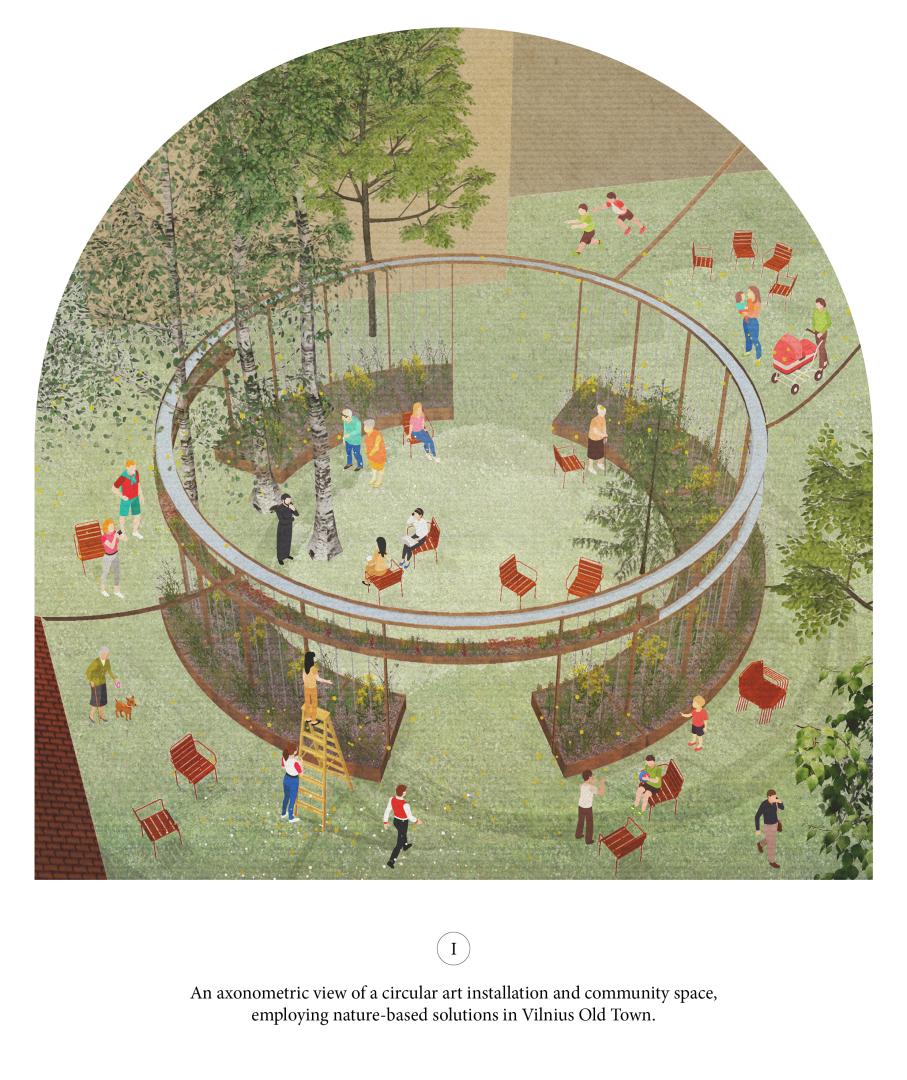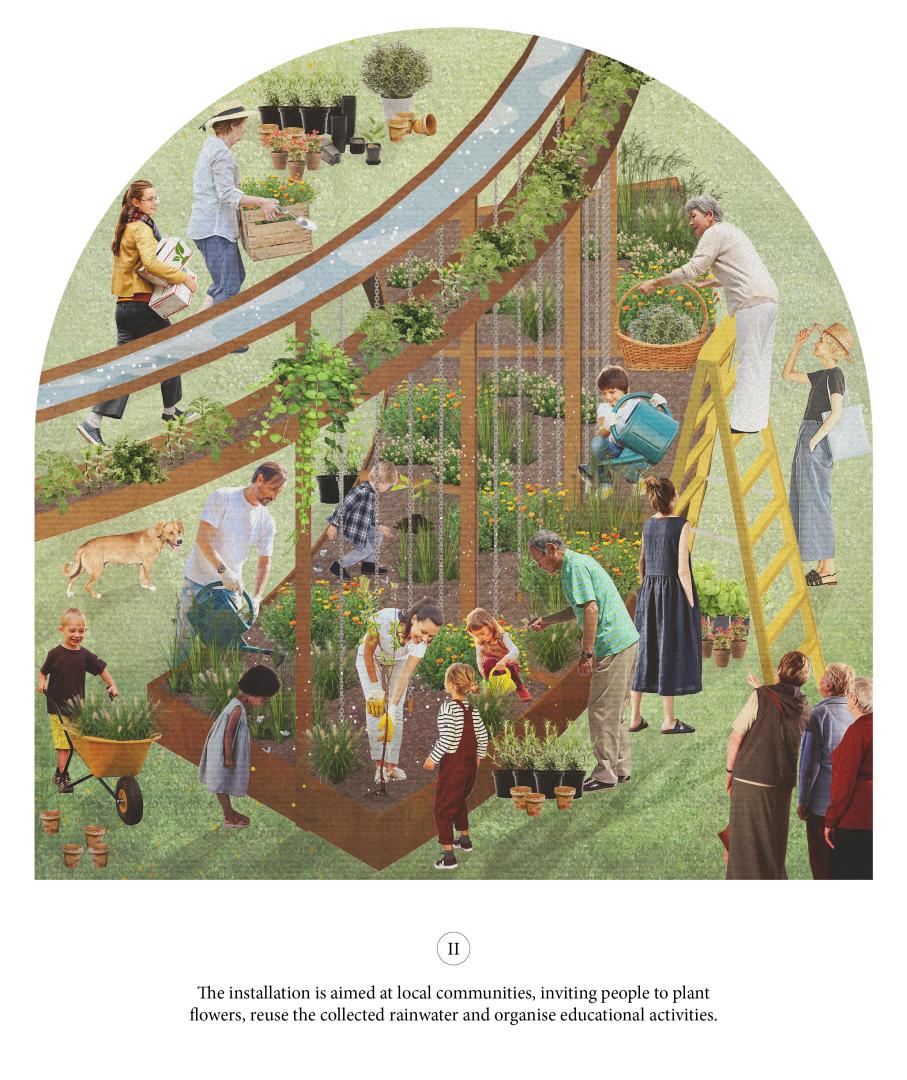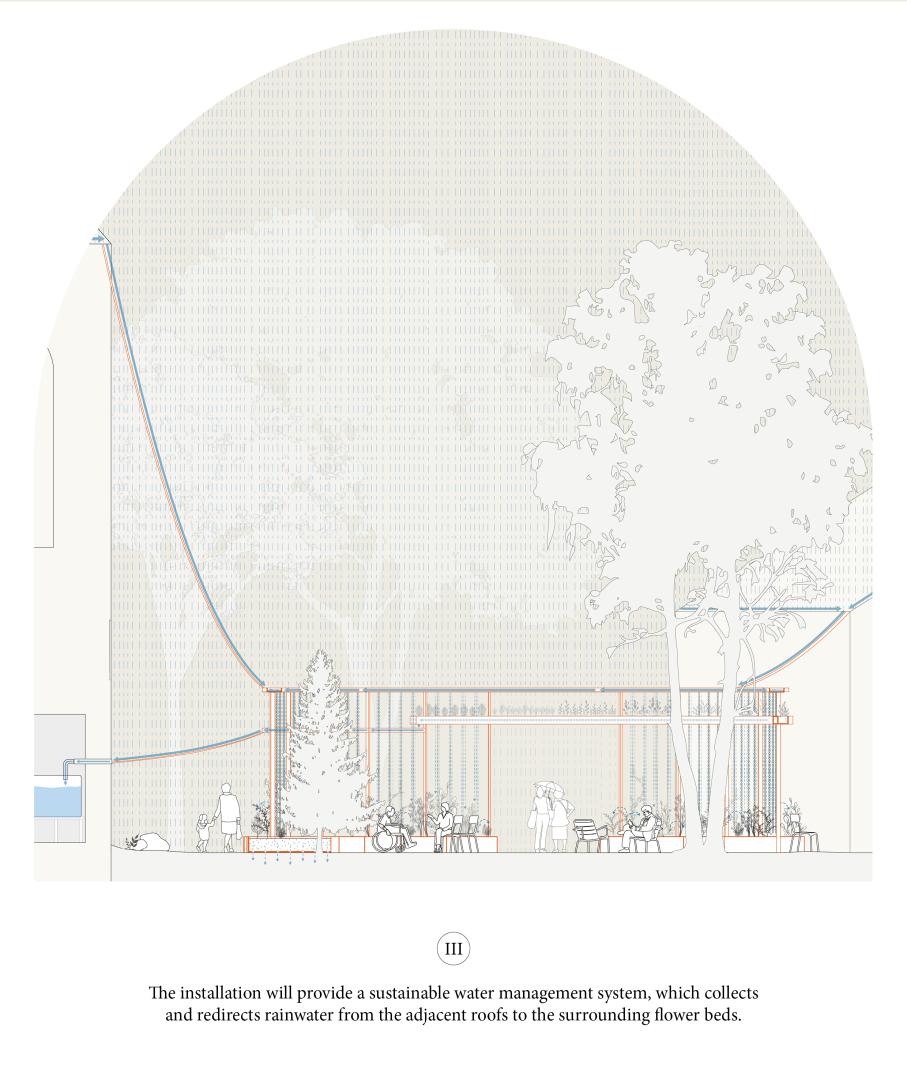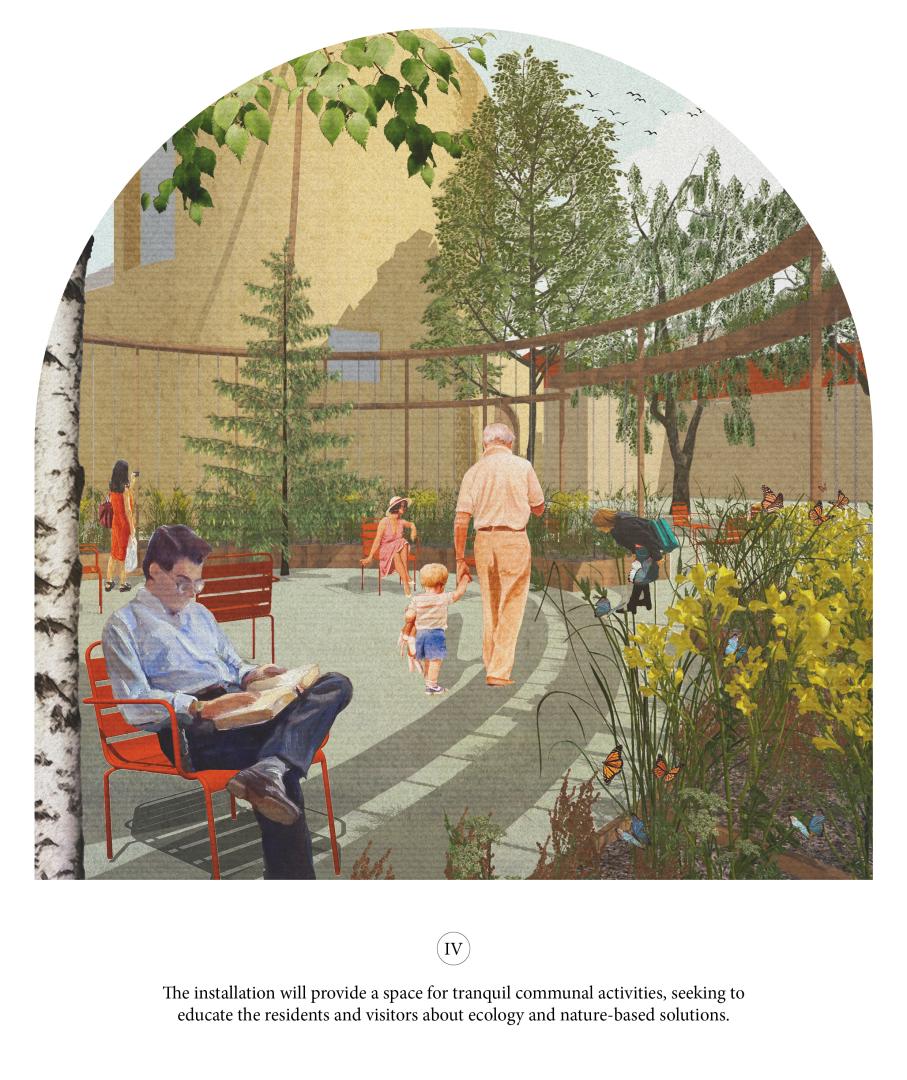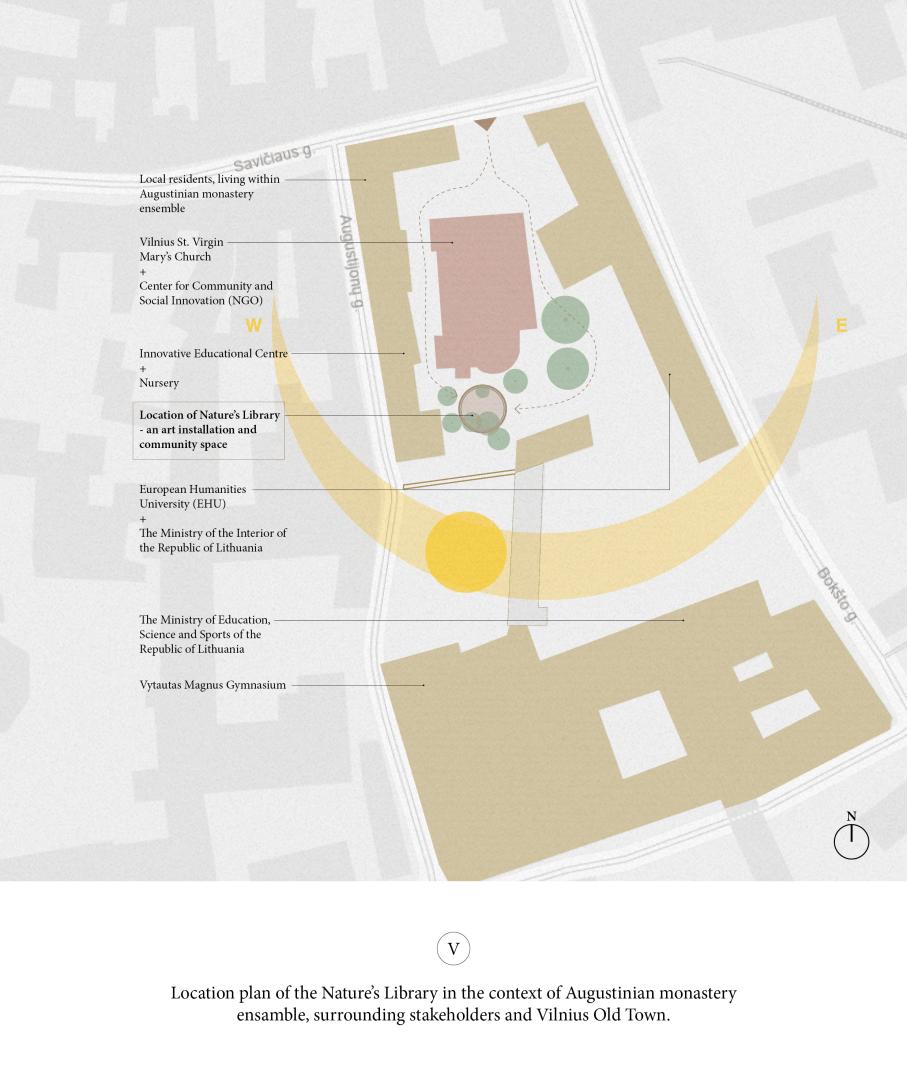Nature's Library
Basic information
Project Title
Full project title
Category
Project Description
Nature’s Library is a nucleus of peace, surrounded by elements of nature expressing the cycles of water and growth. It brings back to life the historical period when an Augustinian monastery existed on the site and connects it with the present by inviting different community groups to interact in one space. The installation merges into the fabric of the historic ensemble by collecting and reusing rainwater and providing the local community with an opportunity to grow herbs and spices.
Geographical Scope
Project Region
Urban or rural issues
Physical or other transformations
EU Programme or fund
Which funds
Description of the project
Summary
The installation aims to revitalise a historic inner courtyard in the Old Town of Vilnius and reveal its heritage and identity through the involvement of the local community and the use of nature-based solutions. The courtyard is situated in a unique Augustinian monastery ensemble with diverse community groups coexisting within the territory - a university, a gymnasium, a nursery, local residents, a police orchestra and a chapel.
The frame of the circle-shaped installation is constructed using weathered steel components that hold dozens of metal chains, acting as rain downpours and creating a permeable veil around the inner space. The open structure will sensitively blend into the existing space and create a meditative, intimate environment inside it. At the same time, it will serve as an NBS element, collecting rain from the surrounding buildings and directing it to modular plant beds that form the base of the installation. The plant beds would consist of 17 identical modules with perforated bottoms. Top components of the structure, serving as rain collection channels, will be assembled from smaller pieces, aiming to keep the construction process as simple as possible and maximise the mobility of the installation.
The plant beds will be used to grow different kinds of flowers and shrubs, typically used to make traditional local decorations - Easter palms, thus celebrating the authentic local tradition of the Vilnius region. This way the vegetation will not only contribute to managing the rainwater and improving the local microclimate but will also perform an educational function, turning the installation into a living natural library that will be different depending on the time of the year or weather conditions.
The installation aims to involve the surrounding community as much as possible, inviting people to plant flowers, reuse the collected rainwater, and organise educational or other activities in the newly created space.
Key objectives for sustainability
The old town is a compact and vibrant part of Vilnius, but like many other old towns in Europe, it has an insufficient amount of quality green spaces and green infrastructure. The school and nursery surrounding the Augustinian monastery ensemble lack outdoor learning opportunities or quieter outdoor activity spaces for children. Also, the residents living around the site complain about the pedestrian areas flooding after heavy rains each year.
One of the main focuses throughout installation’s development was to respond to the current environmental issues presented by the site by employing NBS and establishing a new, self-sustaining green space, while also paying close attention to the existing historic context and the installation's educational role on the principles of circularity.
The installation will provide a sustainable water management system, which will allow to collect and redirect the rainwater from the adjacent roofs. This will help to lower the pressure on the site's drainage system and subsequently avoid flooding. The rainwater will be directed through several levels of weathered steel arches of the installation, part of it will be collected and used to irrigate tea leaves and herbs grown by the local community. This process will also act as a primary water treatment, after which the water can be diverted to further filtration facilities and used for tea or other purposes by tenants of the church building, taking an important step towards the development of the territory’s circular ecosystem. Plants and water will help create new natural habitats, increase biodiversity and regulate microclimate.
The primary objective here is not necessarily to produce tangible change (e.g. managing flood risk) per se, but to help citizens realise the goals they might find worthwhile to pursue. By exploring the space and elements in the installation, visitors will learn the principles of sustainable and circular rainwater management, ecology and green infrastructure.
Key objectives for aesthetics and quality
Augustinian monastery ensemble has gone through many changes in the past, and today the variety of styles, colours and historic layers are still visible and embedded on the site. The church, sitting next to the proposed Nature’s Library, has experienced industrial transformation during the Soviet occupation, when it was turned into a vegetable warehouse. The installation seeks to reflect this difficult and ruthless industrial period through its materiality, by use of corten steel for the fabrication of installation’s structure and base modules.
On the other hand, the values cherished by the Augustine monastery - the harmony of the heavenly and earthly worlds and the desire for continuous improvement through learning and knowledge of nature, - as well as the colours and uplifting mood of Baroque, will be conveyed through the installation’s spatial composition and the colourful planting. The layout of the installation is based on a grid of 24 sections, reflecting the radius of the church’s apse. The plant selection and their curated arrangement will reference both the former botanical garden which existed in the middle of the complex and the large Augustinian library that operated in the monastery centuries ago. Thus, the overall spatial intervention will highlight the intangible value of the monastery's mixed cultural identity associated with both its medieval and soviet history and will help better represent this juxtaposition on the exterior of the church.
The installation will create a clear focal point in the heart of the site and will invite the community and visitors to come and interact. Natural elements of trickling rainwater and lush vegetation will create a meditative space, pleasant to spend time in, meet people and participate in various informal events.
Key objectives for inclusion
The uniqueness of this project is a great diversity of stakeholders representing all sectors of the society: government, public institutions, Vilnius city municipality, non-governmental and non-profit organisations, educational institutions and other organisations, the religious community, private businesses, local residents and the general urban population. Nature’s Library aims to bring all of these people from various backgrounds and different age groups together through education about nature and participation in creating nature-based solutions.
Installation’s users will not be just passive spectators but will become part of its circular ecosystem. They will be able to contribute to the planting and care of the vegetation, pick spices and herb leaves growing on different parts of the installation and use them at home or make tea at the nearby café.
During the construction of the installation, workshops would be held in stages to involve members of different community groups. Plant modules would be implemented together with the local community and children from the adjacent nursery and gymnasium. This includes not only the planting itself but also making decisions on the layout and species of the plants. The exact uses for collected rainwater would also be decided together with the tenants from the surrounding buildings.
Thus, the installation will provide these different inclusion and engagement opportunities:
- developing knowledge of nature and learning to grow vegetables and plants (nursery or gymnasium)
- use of the grown vegetables, spices and herbs for various purposes (residents, church cafe, nursery, gymnasium)
- use of the collected rainwater for different purposes
- learning how to make traditional Vilnius Easter palms and wreaths (local and wider community)
- space for local community to meet and interact, organise communal lunches, yoga, readings and other activities (nursery, gymnasium, church community, residents, university students etc.)
Physical or other transformations
Innovative character
As described in the previous sections, environmental sustainability, including circularity, has been the driving idea behind the design of the installation.
Aesthetical experience is the natural result of this careful design working in synchronicity with the unique historical background of the site.
And finally, inclusion is the main reason why the installation was initiated in the first place: engagement of the local community and creation of a thriving, self-sustaining shared sense of ownership with its surrounding environment has been the underlying cause and the overarching principle of the wider initiative that is behind the revival of the monastery ensemble. It was also one of the main factors that determined the selection of Nature's Library as a winning idea for one of the steps in the long process of regenerating the site.
Therefore, the installation is born from a process that is carefully steered to be as inclusive as possible, and, at the same time, its transdisciplinary design in itself creates a new shared community space that encourages different stakeholders to meet in a neutral environment and continue the ongoing discussions on the future of the monastery ensemble, hopefully helping different landowners and users to agree on land use procedures, functional areas and activities.
As one of the many strategic steps, Nature’s Library would help the Augustinian monastery ensemble to communicate its aspirations and values and spread ideas further throughout the city.
If realised, the whole process of how the installation has come about and the way its design seeks to create sustainable relationships with its context on multiple different layers - through sensitive reactivation of a derelict space, education on the role of NBS and engagement of the community - would present a very important precedent for a more meaningful and refreshing way to shape our environment, particularly in the context of Lithuania but also the wider region.

